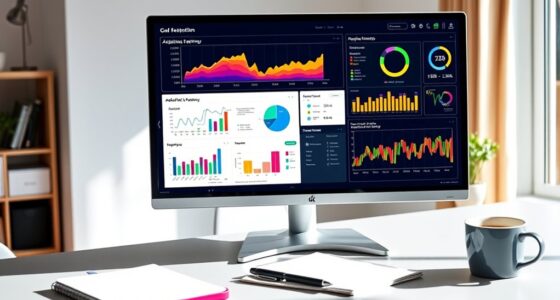When you explore correlation versus causation in assignments, remember that correlation shows two things happen together, but it doesn’t prove one causes the other. Assuming causation from correlation can lead to false conclusions, especially if a third factor influences both variables. To avoid mistakes, look for additional evidence and consider potential confounding factors. Understanding this difference helps you analyze data accurately; if you want to learn more, there’s plenty to discover.
Key Takeaways
- Clearly distinguish between correlation (relationship) and causation (cause-effect) in your assignments to avoid misinterpretation.
- Use visual aids like scatter plots to identify correlations but seek additional evidence for causation.
- Discuss potential confounding variables that may influence observed relationships in your analysis.
- Support causal claims with controlled experiments, longitudinal studies, or credible evidence.
- Emphasize the importance of critical thinking and proper methodology to differentiate correlation from causation.

Many people confuse correlation with causation, but understanding the difference is essential when analyzing data. Recognizing this distinction helps you avoid common statistical pitfalls that can lead to false conclusions. Correlation indicates a relationship between two variables—when one changes, the other tends to change as well. However, it doesn’t mean that one variable causes the other to change. This confusion often results in misleading interpretations, especially when trying to establish research validity. If you mistake correlation for causation, you risk drawing incorrect conclusions that can compromise the integrity of your assignment or study.
Correlation and causation are not the same; understanding this distinction avoids false conclusions in data analysis.
When you rely solely on observed correlations, you may overlook the complexities behind the data. For example, two variables might move together simply because they’re both influenced by a third factor. Ignoring this possibility can lead to faulty assumptions about causality. It’s important to remember that correlation does not imply a cause-and-effect relationship. Instead, it’s a statistical association that warrants further investigation. If you jump to causation without proper evidence, you risk falling into the trap of overgeneralization, which diminishes the accuracy and research validity of your findings.
Furthermore, understanding the difference between correlation and causation helps you avoid common statistical pitfalls. One such pitfall is confounding variables—factors you haven’t accounted for that could influence your results. For instance, a correlation between ice cream sales and drowning incidents might exist, but it’s not because eating ice cream causes drowning. Instead, both are linked to a third factor: hot weather. Recognizing these confounding factors is vital in ensuring your analysis remains valid and credible. Additionally, in appliances and energy usage, understanding power consumption patterns can help identify whether changes are due to actual usage or external influences like standby power.
In addition, misinterpreting correlation as causation can lead to flawed decision-making. If you assume causality without proper evidence, you might implement policies or make recommendations based on incomplete or incorrect data. That’s why, in research validity, establishing causation requires more rigorous methods, such as controlled experiments or longitudinal studies, rather than relying solely on correlation data. Your goal should be to understand the underlying mechanisms behind the data rather than just observing associations.
Ultimately, being cautious about correlation versus causation enhances the quality of your analysis. It prompts you to dig deeper, seek additional evidence, and avoid jumping to conclusions. By understanding this distinction, you improve your ability to interpret data accurately, avoid statistical pitfalls, and produce more reliable, valid research findings. Remember, correlation might suggest a relationship, but causation confirms it—knowing the difference is key to sound analysis and well-founded conclusions.
Frequently Asked Questions
How Can I Identify Causation in Complex Datasets?
To identify causation in complex datasets, you should start with strong experimental design, controlling variables to isolate effects. Use data visualization to spot patterns and potential relationships. Conduct randomized controlled trials when possible, or apply statistical methods like regression analysis to test for causality. Remember, correlation alone isn’t enough; thorough experimentation and clear visualization help you confidently determine causal links in your data.
What Are Common Mistakes When Interpreting Correlations?
You might mistake a spurious relationship for real causation, like confusing two coincidental rainbows for a cause-and-effect link. Common errors include overlooking variables that influence both factors, leading you to falsely connect unrelated data points. Don’t assume correlation equals causation without digging deeper. Always question whether hidden variables or chance are at play, and remember that just because two things move together, it doesn’t mean one causes the other.
Can Correlation Ever Imply Causation? Why or Why Not?
Correlation alone can’t imply causation because it might be a spurious relationship, where two variables appear linked but aren’t causally connected. You need causal inference to determine if one variable directly influences the other. Just because two things move together doesn’t mean one causes the other; lurking variables or coincidence could be behind the correlation, so don’t jump to conclusions without further evidence.
How Do Confounding Variables Affect Correlation Analysis?
Confounding variables can cleverly conjure spurious relationships, skewing your correlation analysis. When lurking variables influence both factors, they create false associations that seem meaningful but are misleading. You might think two variables are connected, but in reality, an unseen factor drives their link. To avoid this, identify and control for confounders, ensuring your analysis accurately reflects genuine relationships rather than deceptive, lurking variables.
What Statistical Tools Help Distinguish Causation From Correlation?
You can use statistical tests like regression analysis, Granger causality, and the chi-square test to help distinguish causation from correlation. These tools allow you to examine relationships more rigorously and identify potential causal links. Causal inference methods, such as randomized controlled trials or instrumental variables, further strengthen your analysis by controlling for confounding factors. Together, these tools help you move beyond mere correlation and better understand cause-and-effect relationships.
Conclusion
Remember, just because two things happen together doesn’t mean one causes the other. For example, studies show that ice cream sales and drowning incidents both increase in summer, but eating ice cream doesn’t cause drownings. Recognizing the difference helps you make smarter decisions and avoid false assumptions. So next time you see a pattern, ask yourself: is it correlation or causation? Staying curious and critical keeps you a step ahead.










